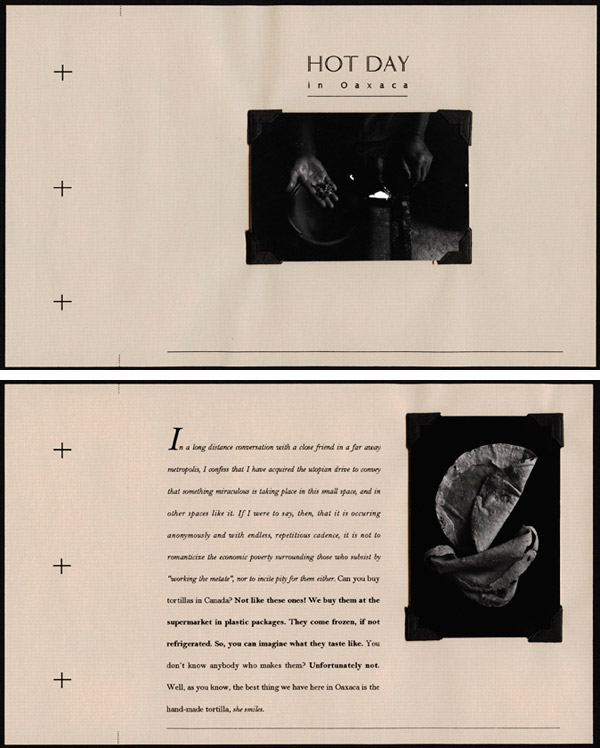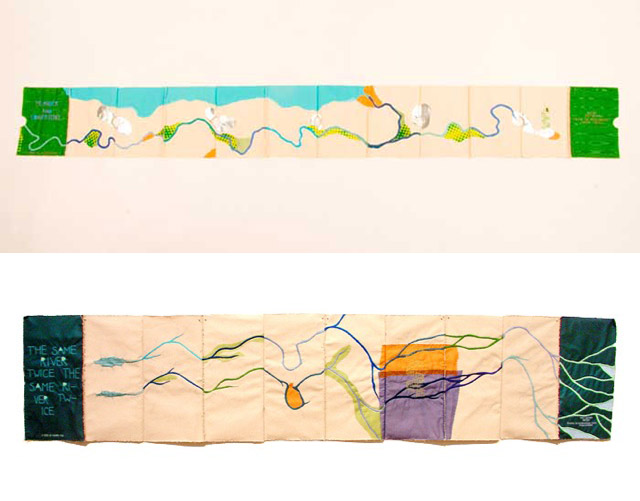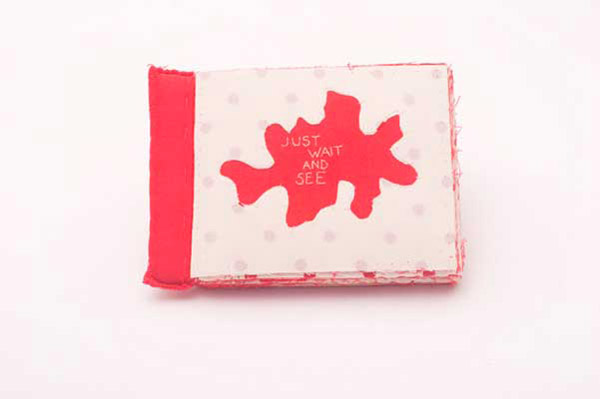In 1572, astronomer and alchemist Tycho Brahe observed an incredibly bright star within the Cassiopeia constellation. A few months later the star disappears and Brahe publishes a small book in 1573, coining the phrase nova for a new star. We now understand this term as a supernova or the death of star. In 2009, Dianna Frid created this artist book Stardeath out of canvas and silk. The geometric layout of each page is embroidered with floss, additional details are added with aluminum foil and cellophane.
Posts Tagged ‘dianna frid’
-
Book Artist of the Month: Dianna Frid
February 25, 2013 by Erin Fletcher
-
Book Artist of the Month: Dianna Frid
February 18, 2013 by Erin Fletcher
In 2007, Dianna Frid created Meander and Convergence using canvas and silk with hints of thread and foil. Imagery of rivers and staircases recur throughout Dianna’s work as symbols of time, cycles and finitude.
Below you can see the similarities between Meander and Convergence and The Same River Twice, The Same River Twice. Both artist books were constructed as an accordion structure and therefore the entire content can easily be seen at once. Each book also includes an embroidered image of a spiral staircase.
The staircase as a symbol has also appeared in Dianna’s sculptural and installation work.
-
Book Artist of the Month: Dianna Frid
February 11, 2013 by Erin Fletcher
Dianna Frid found inspiration in the tragic story of celebrated cave explorer Floyd Collins and in 1998 she constructed this memorializing embroidered cloth book. Using a heat transfer technique, Dianna also included a found image of Floyd Collins. This is one of Dianna’s first fabric books to use found imagery becoming a pivotal point in her approach to narration.
I asked Dianna to include a few words in regards to the concept behind Floyd Collins, Cave Explorer.
It is, in essence, a narrative book that shows you, not only tells you, what happened to this minor historical figure from Kentucky in the 1920’s. As such, it is an exploration of the potential of the form to use a sequential progression of layers to achieve narrative coherence that echo the story. This happens again in Leak, for example, and in Reversal, although both of those books are comprised by words only. In Floyd Collins… each layer is visible at once when you first open the book because there is a large hole on each page. The hole gets smaller as the pages progress, and they eventually bury Floyd Collins (his photograph).The story of Floyd Collins is compelling on many fronts, not only because of the ironic tragedy it exemplifies. In the history of American journalism, he became the first ordinary person who rose to celebrity due to a tragedy: he got stuck and died while he was trying to explore an alternative entrance to the larger network of caves that comprise Mammoth Cave. Floyd Collins was an adventurer-explorer, and he was looking for “more.” I found out about his story—or, more aptly his story found me—while I was perusing a textbook on Physical Geography. I was struck that a scientific book with the mission of teaching us about the earth’s layers, volcanoes, and rock formations included this brief vignette of an unknown, illiterate farmer. I was assailed by the interlude. The stitched words of the artist’s book are sourced from the textbook, and I, of course, give attribution to the authors of the textbook in the colophon.
-
Book Artist of the Month: Dianna Frid
February 4, 2013 by Erin Fletcher
The artist book Just Wait and See was my first exposure to Dianna Frid’s work, which is housed in the Joan Flasch Artists’ Book Collection at the School of the Art Institute of Chicago. The book is constructed with cloth and thread with images applied through heat transfer. The book was always a favorite of mine to view each time I visited the JFABC. Although I anticipated the outcome of the gun shooter, it never halted my interaction with the book.
-
February // Book Artist of the Month: Dianna Frid
February 2, 2013 by Erin Fletcher
The Waves is an artist book by Dianna Frid created in 2011, taking inspiration from Virginia Woolf’s experimental novel of the same name, which Woolf said she wrote “to a rhythm, not a plot”. Exploring this same idea, Frid focused on the structure of the book form itself. Using canvas and cloth for the pages, the word ‘wave’ is embroidered once, then twice, slowly building up to six repetitions per page before retreating out of sight. In addition to the repetitious text is a build-up of material which include various fabrics, paper, acrylic paint and cellophane.
Frid was born in Mexico City before immigrating to Vancouver as a teenager. She currently lives and works in Chicago as both an artist and Assistant Professor at the School of Art and Design at the University of Illinois at Chicago. Come back every Monday this month for more posts on Frid’s work.
You began making artist’s books in 1993 while living in Vancouver, Canada under the pseudonym The Artery Archives. Did you have prior training or knowledge of bookbinding? What structures/form did your first bindings take?
In 1993 I returned to Vancouver after living in Oaxaca, Mexico for about six months. I had finished my undergraduate studies in anthropology and sculpture, which I undertook in part at Hampshire College (in Amherst, Massachusetts) and then at the School of the Art Institute of Chicago. Spending time in Oaxaca fortified my interest in pre-Columbian and early post-conquest codices that were made in that region and throughout Central Mexico. These codices are rich pictographic narratives that often depict the trajectory of a journey. As someone who had migrated from Mexico to Canada in her teens, I identified with the theme of movement and traversal and this is how I began to make some works.
excerpts from ‘La Malinche Sueña que Hernán Realmente la Quizo (Malinche Dreams that Hernán Really Loved Her)’, based on a collaboration with Sergio Santamaría. 1995. edition of 4. Digital typeset with silver negative prints.
When I returned to Vancouver I took a course in desktop publishing, a new thing at the time. It was a very basic and completely instrumental course that was entirely divorced from any kind of theoretical or historical connection to graphic design, but it became the beginning of my attempt at making books, and has turned into an ongoing area of research and interest
When I came back from Oaxaca to Vancouver, I had hundreds of negatives of images that I had taken while I lived there. My parents had a darkroom in their home, and after much editing, a few of the photographs became the content of my first books. Some of the books were based on interviews I conducted with a woman who made corn tortillas for a living. In retrospect I see it as a very elementary “ethnography of process” (I had studied anthropology in college after all). Another early book consisted of photographs based on images taken during a performance and ephemeral installation piece that a group of friends and I created. These books were made in editions of four and some of them are now housed in special collections libraries.

unbound excerpts from ‘Album of an Interview’. 1995. edition of 3. digital typeset and silver negative prints.
With one exception, I have not made multiple editions since—my books have been one-of-a-kind artifacts. In terms of what held the pages together, my bindings were (and still are) rudimentary. I know that the binding styles that I use have names, but frankly I do not know what to call them. Perhaps I can learn from you! This is a peculiar if not ironic fact given that in my work I have often researched nomenclature systems. But to answer your question about binding, which I know is a topic dear to you, my approach to binding has been urgent and intuitive. Nobody taught me how to do it.
In an interview with Violet Shuraka of Cheap and Plastique, you spoke of the structure of the book as ‘a site where movement yields to movement from one pair of pages to another’ similar to navigating oneself through the structure of a building. Can you elaborate on how your concepts are best expressed through the book form and not another avenue of art in which you work?
Holding a book in one’s hands can be a profoundly intimate experience. It is a tactile, interactive object. This fact applies to all kinds of books –not only artist’s books—and it can be a problem when artists’ or rare books are exhibited in vitrines, protected from touch or activation.My long-standing production of one-of-a-kind handmade objects represents an engagement with lineages of craft in a domain that has, for the last several centuries, increasingly been mechanized: first as print and most recently as digital dissemination. Like my manual transformations of other mechanically reproduced representations (charts, graphs, blueprints), my artist’s books draw sensuous attention to the potentials of a form – the book – that, in its predominant mass-produced version, has come to seem little more than a neutral, even disposable medium for conveying information in linear sequence. By calling attention to the embodied physicality of the book, I push against this neutralization.
In terms of content, my artist’s books pull together concerns with translation. My books address the translation between language and its material embodiment as text and image, as well as the translation between sensation and objects—even in the absence of language. Like the rest of my work, my books, in a less format-specific sense, are explorations on how art contributes to our described experiences of time, sequence, light, space, mortality…
I was first introduced to your work as a student in the book arts at the School of the Art Institute of Chicago; a few of your pieces are housed in the Joan Flasch Artists’ Book Collection. At the time I was drawn to your work due their uncommon tactile characteristics and the pleasure I would find in handling them. Historically, we view a book as having either paper or vellum pages with text applied by hand or printed. Your book structures employ the use of cloth and thread, along with other materials. Have you always worked with these materials to create book forms? How do these elements project your themes and concepts as oppose to those more traditional to the book form?
As I mentioned earlier, the first books were photographic editions in which an ephemeral event, a conversation, or a sculpture was documented and encapsulated sequentially. Over time, I started to use components traditionally used for the binding of pages, namely thread and needle, as the tools for marking and configuring content. This became an opportunity to think critically about craftsmanship and to expand on delineations of drawing and mark-making within contemporary art, beyond book works.I can speak about specific examples of books in which the work needs to be sewn because it delineates very clearly the content of the books and the relationship between “front-and-back” that sewing produces on two sides of the same piece of fabric. This is evident right away in “The Plot of the Story” and in “Leak;” and I revisit the concept of back-and-front in “Reversal.” These books explore the potential that a book holds for reversing time, reading backwards, reading something more than once, making text or icons defamiliarized or weird by means of repetition. Through this process I have come to understand in a fully embodied way that language is a material itself composed of smaller units. I had always understood this factually, yet the making of artist’s books generates an embodied understanding: the tactile staging of this fact.
Book Arts continually challenges the definition of a book by reformatting the structure, using unconventional materials and omitting the text. Your books very much rely on imagery to advance the viewer. In the same interview with Shuraka, you so beautifully describe this as ‘rhythm without plot’ as initially explored by Virginia Woolf in her novel The Waves. Can you talk about how you formulate a fluid composition that will guide the reader from page to page?
My first books were perhaps more guided by a narrative sequence. An example would be “Just Wait and See,” which you have seen at the Joan Flasch Artists Book Collection in Chicago. My works emerge from a dedicated studio process that also includes sculpture, drawing, collage, and installation. Over the years these pieces have become less representational, more formal, and in commensurate ways also thematically more open-ended. This includes the artist’s books, but to different degrees. The way a book unfolds in time is related to the concept of montage in film. I do not make moving-image work, but the books, as sequential vessels of time, require the production of a flow. This may happen immediately or it may take a lot of planning. I first plan out the books with tiny sketches and the rest follows.The example of the Virginia Woolf reference is important because once I came cross it I could not shake it off. It stood for what I look for in the books. I had read somewhere that “The Waves” was Woolf’s favorite among her own works, but she also understood it was more difficult for a wide audience to embrace because in it she had been “looking for rhythm, not plot.” This stroke me as inherently poetic and important— as a gesture that encapsulates the significance of PROCESS and RHYTHM that I engage in the studio performance of making art.
You’ve been working with the book as an art form for over 15 years, how do you see your work evolving within this medium?
Lately, I have been thinking about making limitless editions on CreateSpace, Amazon’s self-publishing site. This would be an experimental start for what I want to see becoming more accessible copies of artist’s books that I have made in the past. Because the medium is so different, I am excited to change the aspect of the books in ways it might require. As you know, my one-of-a-kind books circulate in very different modes from the way multiple editions are able to reach an audience, and I am curious to make an artist’s book that has a life that exceeds the singular copy.I will still continue to make the one-of-a-kind books because I have constant ideas for these. However, it is not unusual for me to need months or even years to actually figure out how to execute a specific idea in book form. This was the case with “Reversal,” for example, a book that I wanted to make five years prior to figuring out how… Some book ideas fail or never materialize. For example, I wanted to make a book that dealt with Odysseus surviving the Sirens, but instead the book idea resulted in a sculpture that is now called “I Alone Was to Hear Their Voices…” It’s a long story, but the fact is that the initial idea resolved itself into the form it needed to become, which was not a book. As you can see, in my work there is a back-and-forth between non-book objects and book objects. They inform and enhance each other.
-
Coming Soon: Hannah Brown // Dianna Frid
January 1, 2013 by Erin Fletcher
Starting in February I’ll continue featuring bookbinders in my Bookbinder of the Month column, starting with the incredibly talented Hannah Brown, who masterfully adds embroidery work into her fine bindings. Another spectrum of binding I want to focus on are artist books, beginning with the ingenious work of Dianna Frid, whose soft fabric books whimsically explore philosophical themes concerning the nature of reality.
Every month dive further into the binding community with another artist and craftsman. Don’t miss a post, it may inspire something in you!



























